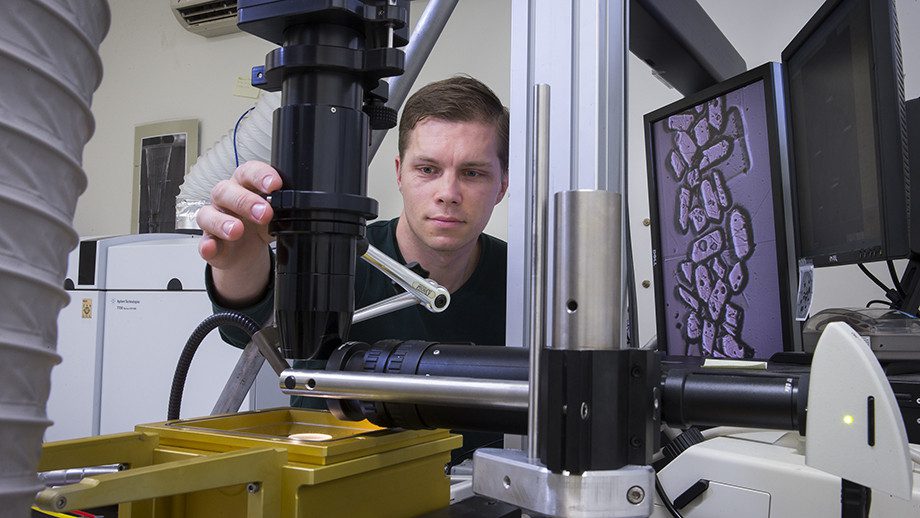Geologists at the ANU have provided another clue towards unravelling the mystery of early Earth’s nature.
A team of researchers from the university’s Research School of Earth Sciences studied grains of the mineral zircon, found in the sandstone of Jack Hills, Western Australia. The Jack Hills are home to a concentration of the oldest zircon crystals in the world. The results suggest that there was very little tectonic activity during the Hadean period of Earth’s history.
The Hadean period began with Earth’s formation, 4.6 billion years ago, and ended 4 billion years ago. The oldest zircon crystals found at Jack Hills are about 4.26 billion years old.
No rocks have survived from the Hadean period, so the zircon found in the sandstone of Jack Hills provides vital clues to what happened during this time.
Speaking to Woroni, lead researcher Dr Antony Burnham said: ‘These Jack Hills [zircons] are really the sole fount of knowledge about the first 400 million years of earth’s history.’
Like analysing skin cells at a crime scene, geologists must engage in detective work to draw a picture of Earth’s earliest days from the minuscule grains.
To extract and analyse the zircon is an involved process requiring inventiveness and plenty of gadgetry. The zircon crystals must be sifted, over multiple steps, from the other elements found in the sandstone samples. They are then mounted ready to examine with an electron microscope, or be vaporised with a laser so the resulting gas can be analysed by mass spectrometer.
The study was an ANU effort, with the most recent research building on the efforts of previous projects.
‘It was actually researchers here at ANU who back in the 1980s who built a machine specifically to analyse the age of the mineral zircon,’ Burnham said. ‘And then the other aspect we were building on was work done here at ANU studying the granites of the Lachlan Fold Belt.’
The Lachlan Fold Belt is a series of granite structures stretching across southeast Australia. Burnham’s team compared the composition of zircons in the better understood granite formations from this region, to the Jack Hills zircon.
‘We used the zircons from these rocks in southeast Australia to identify a fingerprint for either sediment melting or igneous rock melting,’ Burnham explained.
Their detective work uncovered striking similarities between the Jack Hills zircon, and samples in the Lachlan Fold Belt formed from melted older igneous rock. The evidence that there was little sediment melting during the Hadean era suggests that early Earth did not have plate tectonics.
‘One of the main ways you get sediment melting is you need to take sediments from the surface of the earth down to somewhere where they get hot enough to melt, and that’s usually tectonic forces,’ Burnham said.
With so few surviving samples, discoveries such as that of Burnham and his team provide valuable lines of evidence.
First of all, they reveal more about the what Earth was like relatively soon after its formation. Without plate tectonics, the process we know today, of crust forming at mid-ocean ridges and spreading, would not have existed. This means that processes like those that formed diamonds, would have been non-existent, or far different from today.
In fact, drawing on both these results and previous findings, it seems possible the Earth had very little by way of continents at all. Instead, smaller islands likely emerged from a sea covering most of the planet.
Tectonic plate collisions also form mountain ranges like the Himalayas and the Alps, which are important for moderating the planet’s climate.
‘When you have mountains, as they weather and erode they actually draw down large amounts of carbon dioxide from the atmosphere,’ Burnham explained. ‘So the fact that you didn’t have that process going on back then means potentially we had much higher levels of CO2 in the atmosphere before there were plate tectonics.’
Apart from adding new evidence to the debate around early Earth, the findings provide a useful tool for other geologists. Depending on various conditions, such as weather and rock type, some rocks erode much faster than others. Analysing zircon overcomes this difficulty.
‘By looking specifically at the mineral zircon we can see through this bias and try to get a more representative view of earth’s history,’ Burnham said.
There’s plenty more questions about the planet’s evolution to be answered, such as what caused plate tectonics to emerge, and why granite during the Hadean period formed differently to much of the granite now. Burnham hopes that zircon analyses can reveal the processes that allowed useful minerals such as tin, copper, gold and rare earth elements to be concentrated.
‘The great thing about doing research is that you’re always finding something new, and you don’t necessarily know what it’ll be,’ he said.
We acknowledge the Ngunnawal and Ngambri people, who are the Traditional Custodians of the land on which Woroni, Woroni Radio and Woroni TV are created, edited, published, printed and distributed. We pay our respects to Elders past and present. We acknowledge that the name Woroni was taken from the Wadi Wadi Nation without permission, and we are striving to do better for future reconciliation.
